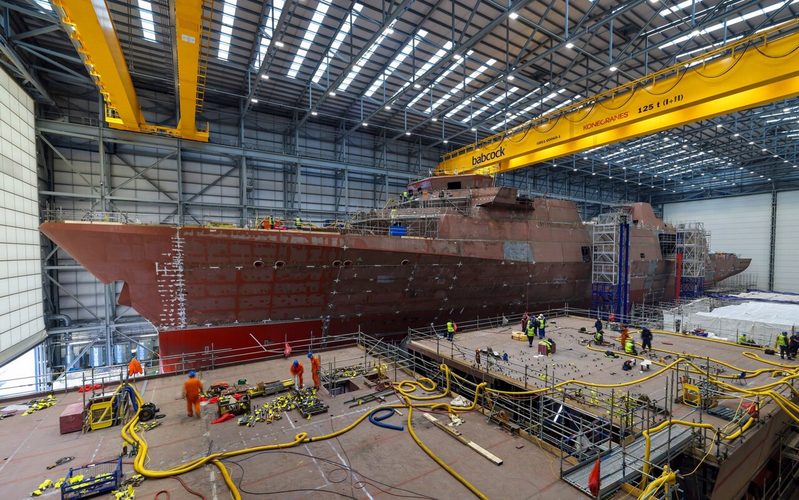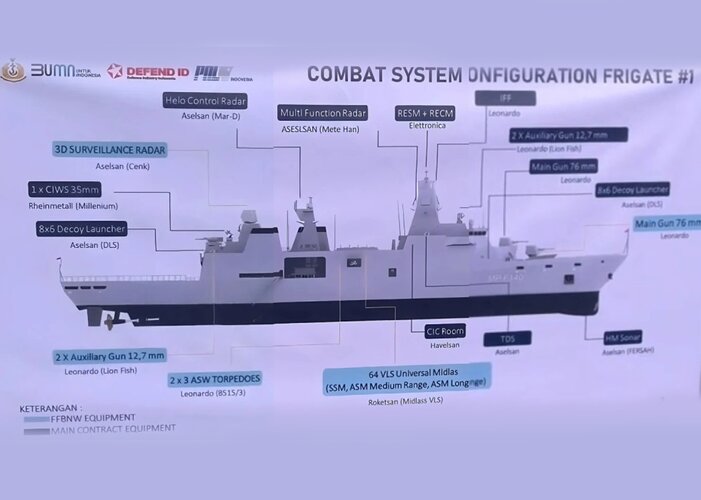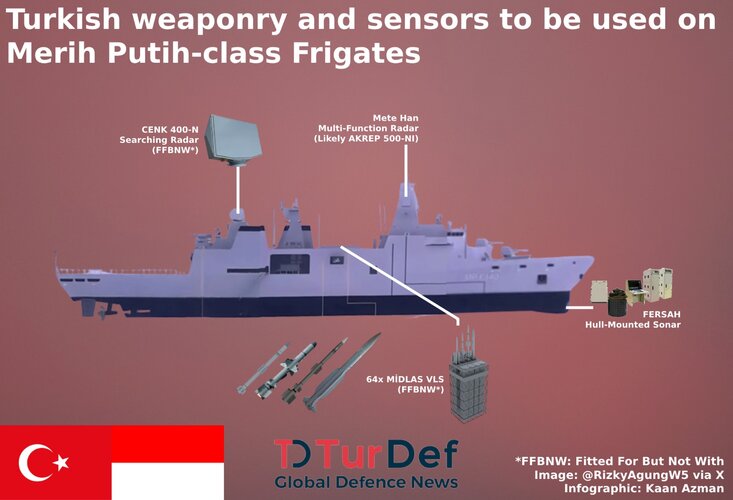aonestudio
I really should change my personal text
- Joined
- 11 March 2018
- Messages
- 2,964
- Reaction score
- 7,481

MdCN is sized for torpedo tube launch from submarines. That repackaging would have been done regardless of SCALP fitting or not fitting a VLS.I don't think Storm Shadow would fit in a Mk 41. If it did, the French would not have gone to the trouble of turning SCALP into MdCN to fit the similar-sized Sylver launchers.
MdCN is sized for torpedo tube launch from submarines. That repackaging would have been done regardless of SCALP fitting or not fitting a VLS.

Whilst i understand the supposed range/min-engagement performance, launch signature reduction and hull structure benefits for CAMM in soft-launch 'mushroom' cells - I don't agree that these benefits stack up against the opportunity costs of not integrating Mk41. This irks me as T45, T26 and T31 were (at the very least) designed for Mk41 on a 'fitted for but not with' basis anyway and recent developments in CAMM/Sea-Ceptor evolution will serve to negate the performance and range loss that soft-launching was supposed to ameliorate anyway. To my mind, why bother with a bespoke launching system when there was already a program to integrate CAMM (and possibly Aster/Sea-Viper) with Mk41 (or ExLS - which is nigh on the same thing) - just do that for naval applications from day one and reap the flexibility of hosting a plethora of other US-origin weapons (the catalogue is growing all the time), thereby future-proofing your platform and maximising bang for your buck!. Mk41 is a flexible, high volume, multi-user system so ongoing costs would be relatively reduced compared to CAMM-only mushroom farms (or aster-only hot-launch tubes - as an aside) which are (i believe?) comparatively low-uptake systems (notwithstanding gestating or new integrations of CAMM New Zealand and Canada, as well as proposed Brazilian, Polish and Indonesian future installations etc - which incidentally may well use ExLS rather than soft-launch tubes anyway (not 100% sure on this I must admit)).
Everyone in RN officialdom is harping on about FCASW, but the way that's tracking it'll end up just like Storm Shadow/SCALP: years late, high cost, low volumes (That's difficult to justify in the current fiscal environment - the arguments about maintaining a sovereign industrial and design capacity for such systems notwithstanding). Mk41 opens up the possibility of TLAM, VL-LRASM (when that comes online - being worked on in a US/AUST joint project right now), SM-3, SM-6 and VL-ASROC. There's even talk of integrating Aster-30 now... What's there not to like!


View attachment 725515
ORIGINAL CAPTION: Scotland are busy building the Royal Navy's Type 31 frigates CREDIT: Barry Wheeler/Royal Navy

Young people must understand their freedom is at risk, says Babcock chief
Interview: Babcock boss David Lockwood on why Britain must raise defence spendingwww.telegraph.co.uk
With the general trend in birth rates, getting enough personnel to crew an enlarged fleet, a larger army, and a more powerful air force may require measures such as increases in military pay, at least after completion of recruit training.Ambitions and needs must first be met by the fundamental requirement of having a large enough body of trained personnel.
Immediately that hits a priority gradient. How much of a population should the military employ?
Type 31 at least has the merit of being lean in crew numbers.
Demography is certainly going to have a profound effect as a driver of the increased use of automated and autonomous systems.With the general trend in birth rates, getting enough personnel to crew an enlarged fleet, a larger army, and a more powerful air force may require measures such as increases in military pay, at least after completion of recruit training.


 tvshows.how
tvshows.how
Steel is cheap. Steel is really cheap.
Build a ship with space and topweight reserves for upgrades, or you're stuck with something like the US Ticonderoga class, which were basically not upgradeable as soon as they were launched. Oh, you could add software, but anything that actually added weight needed something else taken off.
As long as someone keeps beating Treasury over the head about needing the space for upgrades and refits over the 20+year life of the ship...The RN is very familiar with this, its why the Type 45, Type 26, QE Class, River Batch II and Type 31 are larger than they really need to be. They all have spare accommodation and empty areas that can be used over time, plus the spare hotel services etc to cope.
The RN got massively stung with the Leanders, T21 and T42. Great ships, but as a result of the Treasury insistence on smaller sized vessels to 'save money' they were built with little margin for extra kit or developments in service life. The T21 were retired partly because of this. Leander refits were curtailed followingt he epic costs involved. T23 got some margin, but they had to wait for T45 before they could really go full bore on better accommodation and really leaving space, power generation, chilled water etc in abundance.
Hopefully neither the Navy or Treasury will forget that lesson as institutional memory fades...so far so good.
Not sure that the RN swabbies would ever forgive you for being in the same compartment as a Treasury Mandarin, though...Just get Treasury mandarins to fix something on a ship at sea at 03:00 in a violent storm and they will soon appreciate the need for elbow room.

Admiralty: then you can row the ship out (removing cat 'o nine from display case)Treasury: cut fuel budget, no one will be leaving Portsmouth, problem solved
Try and get a matelot to do that these days and you will soon get to know what an elbow in the face feels like ;-)Just get Treasury mandarins to fix something on a ship at sea at 03:00 in a violent storm and they will soon appreciate the need for elbow room.

I have found that my arms don't bend like an octopus nor hands grip like one and they definitely don't have the strength of 20 oxen.Try and get a matelot to do that these days and you will soon get to know what an elbow in the face feels like ;-)
Okay, that paper actually gave me a much better feeling about the RN being at least not-stupid about their levels of manning. When I first read "110 instead of 156" my thought was "great, overworked crew again" but not as bad as the LCS.


Regarding the Polish Navy's planned new Miecznik-class frigate:
View: https://www.reddit.com/r/WarshipPorn/comments/1iy3kgz/infographics_of_the_polish_navys_new/

MIECZNIK-class Multi-Role Frigates, Poland
MIECZNIK-class multi-role frigates are being built to modernise the Polish Navy's fleet. Service entry expected in 2029.www.naval-technology.com
For 4 centuries, royal navy was built for fleet strength over nice ways to spend money for inessential capability. There is no replacement to hull numbers.As long as someone keeps beating Treasury over the head about needing the space for upgrades and refits over the 20+year life of the ship...
Disagree.For 4 centuries, royal navy was built for fleet strength over nice ways to spend money for inessential capability. There is no replacement to hull numbers.
Victory over treasury is flawless - but it resulted in a 3rd tier surface fleet.
That ended up "fitted for but NEVER with"!Disagree.
Treasury forced entirely too many "fitted for but not with" moments.
If a nation didn't fight and FAFOed - this isn't exactly a problem.That ended up "fitted for but NEVER with"!
Oddly enough, no modern surface combatant has ever been lost, or nearly lost, because of the "fitted for but not with" economy measures. The Type 21s and 42s lost in the Falklands were full fitted out with equipment, as was the USS Stark and USS Cole. Moskva might not have been full operable in terms of her fitted systems or even watertight doors but that's a separate issue. ROKS Cheonan had a generously specified equipment fit for her era, all of which was fully operable when she was torpedoed.That ended up "fitted for but NEVER with"!
Oddly enough, no modern surface combatant has ever been lost, or nearly lost, because of the "fitted for but not with" economy measures. The Type 21s and 42s lost in the Falklands were full fitted out with equipment, as was the USS Stark and USS Cole.
Seawolf light was only imagined after the Falklands, got ordered for T42 Batch III in the late eighties and canned in the nineties.Lightweight SeaWolf on T42? What was the timeframe on that again?
Seawolf light was only imagined after the Falklands, got ordered for T42 Batch III in the late eighties and canned in the nineties.
Cheers
Oh, THAT thread, thanks.There was a two-round Seawolf launcher with automatic reloading at least as early as 1980. I don't know if they ever proposed putting this on the T42s — below deck space would be a problem.
Post in thread 'Sea Wolf and Sea Dart: Unbuilt Derivatives and Cancelled Applications' https://www.secretprojects.co.uk/th...ves-and-cancelled-applications.218/post-22045

OCCAR press release
OCCAR is proud to announce the delivery of the first MMCM System (Maritime Mine Counter Measures) to the UK.
The first milestone was reached in 2021 with the delivery of two prototypes/demonstrators to OCCAR Member States France and the UK shortly after its production launch. Industry, National Experts, Managers and OCCAR (Organisation for Joint Armament Co-operation) faced a number of challenges during the development of this cutting-edge technology, which will ultimately allow the rapid destruction of sea mines in a more cost effective and safer manner than in the past, successfully avoiding human intervention during dangerous operations.
The Royal Navy has been trained and is now ready to further develop this new concept, using this technology of drones remotely controlled from a Portable Operation Centre. This First Capability will allow the Royal Navy to conduct operations in complex environments including uncrewed sonar survey missions up to Sea State 4 to maintain precise mapping of the sea floor.
Capability to conduct identification and then training of mine neutralisation at sea is also provided with the delivery of the dedicated Remotely Operated Vehicle (ROV).
OCCAR delivered the first MMCM System to France in December 2024.
– End –


